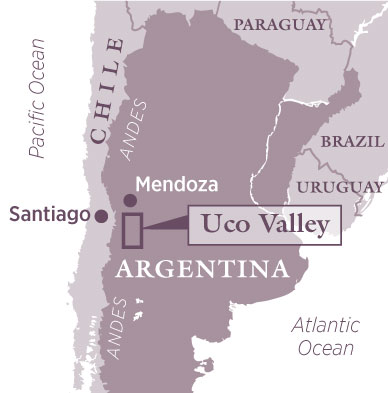It’s remoteness is part of its charm. Anthony Rose heads into the foothills of the Andes to explore the back-to-nature delights of Argentina, in his Uco Valley travel guide.
Uco Valley fact file:

Planted area: 24,000ha
Main grapes: Malbec, Cabernet Sauvignon, Cabernet Franc, Syrah, Barbera, Bonarda, Merlot, Tempranillo for reds; Chardonnay, Sauvignon Blanc, Semillon and Torrontés for whites
Average temperature: 14°C
Co-ordinates: 33°37S 69°08W
For more information: valledeuco.com and turismovinalto.comar
Quick links:
– A perfect day in the Uco Valley
– Where to stay, shop, eat and relax
Introduction:
Take a stroll through a Tupungato vineyard at sunrise and you may just catch a glimpse of a silvery moon sinking as a dazzling golden sun rises to strike the snowcapped volcano’s peak. Accompanying the crunch of gravelly vineyard soil underfoot, the only sounds are birdsong, the occasional bark of a dog or neigh of a horse and the whispering of vine leaves in the breeze. This is the gentle, beating heart of the Uco Valley.
With desert to the south, small hills to the north and dry riverbed country on its eastern border, this picturesque valley is self-contained. But it’s no Napa. Rather, it’s an unspoiled fruit and vegetable garden whose secret lies in its tranquil, back-tonature feel along with scant regard for mass tourism. If you’re looking for ‘bijou charm’, the T-shirt to go with it and a stay at a Hilton or Sheraton, look elsewhere.
If, on the other hand, you love wine and the outdoor life, you will discover it all here. The Uco Valley is a dramatic landscape, with big skies, charming posadas and estancias, small hotels and enticing restaurants. Any time of the year is good to visit, although winters can be cold and summers hot. Autumn is particularly beautiful as the vines and trees turn to 50 shades of amber, russet and gold.
Cool and calm
Take Route 40 across the valley floor and spindly poplar and willow windbreaks that line the road recede into the distance as the wall of changing shapes, contours and silhouettes of the Andes becomes your constant travelling companion. Bisected by a web of tributaries of the Tunuyán River, the Uco Valley is 40km wide and 70km in length, running from the northern department of Tupungato through Tunuyán to San Carlos in the south. Compared to the more traditional regions of Luján de Cuyo further north and Rivadavia to Mendoza’s east, Uco’s poplar-sheltered vineyards sit at a higher altitude of between 1,000m and 1,500m and so are relatively cool.
Since the discovery in the 1990s of the correlation between altitude and elegance in wine, new wineries have mushroomed in Uco, while traditional producers, such as Catena and Famila Zuccardi, have also invested in the region. For this reason, Uco is becoming increasingly popular as a wine playground for both Mendoza residents and visitors from overseas.
Uco is the source of many of Argentina’s greatest red wines, with an array of interpretations of the Malbec grape their number one attraction. Almost as far south as you can go inside the valley before taking the road to San Rafael, the Spanish-owned Bodega O Fournier (ofournier.com) is an astonishing piece of architecture in El Cepillo, with a roof akin to a helicopter landing pad or professor’s mortar board. It’s worth a visit not just for the wines but the restaurant with its backdrop of vineyards and snowy peaks.
The most spectacular of Uco’s wineries is Clos de los Siete (rollandcollection.com), a five-winery complex conceived by the French über-consultant Michel Rolland in the mid-1990s. Set in breathtaking scenery, like a collection of Inca mausoleums, each of the five makes its own wines and contributes to the overarching Clos de los Siete brand.
Further north towards Tupungato, there are wineries whose architecture matches the grandeur of the wines. At Salentein (salentein.com), there’s the Killka Art Gallery and cultural centre, which houses collections of contemporary Argentine art and Dutch artists. Finca Sophenia (sophenia.com/ar) and the Catena-owned Rutini (rutiniwines.com) are worth a visit for their finely crafted Malbecs, while Andeluna’s (andeluna.com) exceptional wines are matched with superb food from its open-plan kitchen.
Unspoiled beauty
Despite a wealth of outdoor experiences in Uco, some would say the region is still under-resourced. Frankly, this is good news for those in search of tranquillity and good wine. With the favourable exchange rate and a thriving black market, the canny traveller can feel rich in pocket as well as in spirit.
Uco is the most unspoiled wine region I know, but not, I suspect, for very long. The O Fournier bodega is selling vineyard plots to investors, and its owner José Manuel Ortega is planning a hotel. The first part of an ambitious new project, Valle de Uco, will open by the end of the year with five luxury tents for ‘glamping’, while Tupungato Winelands and Vines of Mendoza are among a number of ambitious projects in the pipeline.
The dual carriageway out of Luján is being extended from 40km to 70km, which will reduce the travel time from Mendoza City to Tunuyán in the heart of the Uco Valley from 90 minutes to under an hour. So, undoubtedly, in the next 10 years Uco Valley tourism will boom.
For would-be visitors to one of the world’s as-yet least-spoiled wine regions, there’s no time like the present to plan your trip.

Written by Anthony Rose





